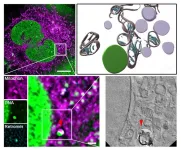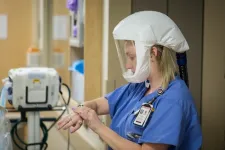(Press-News.org) Quantum states can only be prepared and observed under highly controlled conditions. A research team from Innsbruck, Austria, has now succeeded in creating so-called hot Schrödinger cat states in a superconducting microwave resonator. The study, recently published in Science Advances, shows that quantum phenomena can also be observed and used in less perfect, warmer conditions.
Schrödinger cat states are a fascinating phenomenon in quantum physics in which a quantum object exists simultaneously in two different states. In Erwin Schrödinger's thought experiment, it is a cat that is alive and dead at the same time. In real experiments, such simultaneity has been seen in the locations of atoms and molecules and in the oscillations of electromagnetic resonators. Previously, these analogues to Schrödinger’s thought experiment were created by first cooling the quantum object to its ground state, the state with the lowest possible energy. Now, researchers led by Gerhard Kirchmair and Oriol Romero-Isart have demonstrated for the first time that it is indeed possible to create quantum superpositions from thermally excited states. “Schrödinger also assumed a living, i.e. ‘hot’ cat in his thought experiment,” remarks Gerhard Kirchmair from the Department of Experimental Physics at the University of Innsbruck and the Institute of Quantum Optics and Quantum Information (IQOQI) of the Austrian Academy of Sciences (ÖAW). “We wanted to know whether these quantum effects can also be generated if we don't start from the ‘cold’ ground state,” says Kirchmair.
In their study published in the Science Advances, the researchers used a transmon qubit in a microwave resonator to generate the cat states. They succeeded in creating the quantum superpositions at temperatures of up to 1.8 Kelvin – which is sixty times hotter than the ambient temperature in the cavity. “Our results show that it is possible to generate highly mixed quantum states with distinct quantum properties,” explains Ian Yang, who performed the experiments reported in the study.
The researchers used two special protocols to create the hot Schrödinger cat states. These protocols were previously used to produce cat states starting from the ground state of the system. “It turned out that adapted protocols also work at higher temperatures, generating distinct quantum interferences,” says Oriol Romero-Isart, until recently Professor of Theoretical Physics at the University of Innsbruck and research group leader at IQOQI Innsbruck and since 2024 Director of ICFO - the Institute of Photonic Sciences in Barcelona. “This opens up new opportunities for the creation and use of quantum superpositions, for example in nanomechanical oscillators, for which achieving the ground state can be technically challenging.”
“Many of our colleagues were surprised when we first told them about our results, because we usually think of temperature as something that destroys quantum effects”, adds Thomas Agrenius, who helped develop the theoretical understanding of the experiment. “Our measurements confirm that quantum interference can persist even at high temperature”.
These research findings could benefit the development of quantum technologies. “Our work reveals that it is possible to observe and use quantum phenomena even in less ideal, warmer environments,” emphasizes Gerhard Kirchmair. “If we can create the necessary interactions in a system, the temperature ultimately doesn't matter.”
The study was funded by the Austrian Research Fund FWF and the European Union, among others.
Publikation: Hot Schrödinger Cat States. Ian Yang, Thomas Agrenius, Vasilisa Usova, Oriol Romero-Isart, Gerhard Kirchmair. Science Advances 2025 DOI: 10.1126/sciadv.adr4492 [arXiv:2406.03389]
END
Hot Schrödinger cat states created
2025-04-04
ELSE PRESS RELEASES FROM THIS DATE:
How cells repair their power plants
2025-04-04
Damage to the genetic material of mitochondria – the mitochondrial DNA or mtDNA for short – can lead to diseases such as Parkinson’s, Alzheimer’s, amyotrophic lateral sclerosis (ALS), cardiovascular diseases and type 2 diabetes. Such damage also speeds up the ageing process. However, the cells are normally capable of identifying such damage and reacting.
Scientists from University Hospital Düsseldorf and HHU have – in collaboration with the University of Cologne and the Center for Molecular Medicine Cologne (CMMC) – discovered a mechanism, which protects and repairs the mitochondria. The research ...
Oxygen is running low in inland waters—and humans are to blame
2025-04-04
Rivers, streams, lakes, and reservoirs aren’t just scenic parts of our landscape—they’re also vital engines for life on Earth. These inland waters ‘breathe’ oxygen, just like we do. But a new study led by Utrecht University researchers shows that we’ve been suffocating them during the last century, an era also known as the Anthropocene. The research, published today in Science Advances, reveals that the way oxygen is produced and used in inland waters has dramatically changed since 1900. ...
ACP’s Best Practice Advice addresses use of cannabis, cannabinoids for chronic noncancer pain
2025-04-04
NEW ORLEANS April 4, 2025 – The American College of Physicians (ACP) has issued Best Practice Advice for clinicians whose patients are considering or using cannabis or cannabinoids for management of chronic, noncancer pain. Cannabis or Cannabinoids for the Management of Chronic Noncancer Pain: Best Practice Advice From the American College of Physicians, was published today in Annals of Internal Medicine.
ACP’s Best Practice Advice paper is intended to inform clinicians about the evidence regarding the benefits and harms of cannabis or cannabinoids in the management of chronic noncancer pain and to provide advice for clinicians counseling patients seeking ...
Beyond photorespiration: A systematic approach to unlocking enhanced plant productivity
2025-04-04
A groundbreaking study published in Science Advances has revealed promising strategies to significantly improve crop yields by addressing photorespiration, a metabolic process that can reduce productivity by up to 36% in some crops. Researchers from the University of Groningen and Heinrich Heine University Düsseldorf, working as part of the GAIN4CROPS project (gain4crops.eu), have evaluated several alternative pathways that could help overcome this major agricultural bottleneck.
Photorespiration occurs when the enzyme RuBisCO, essential for photosynthesis, reacts with oxygen instead of carbon dioxide, resulting ...
How a small number of mutations can fuel outbreaks of western equine encephalitis virus
2025-04-04
New research shows how small shifts in the molecular makeup of a virus can profoundly alter its fate. These shifts could turn a deadly pathogen into a harmless bug or supercharge a relatively benign virus, influencing its ability to infect humans and cause dangerous outbreaks.
This is the latest finding in a series of studies led by Jonathan Abraham, associate professor of microbiology in the Blavatnik Institute at Harvard Medical School, and his team that aim to understand the risk of western equine encephalitis virus and related viruses. The work, which was supported ...
Exposure to wildfire smoke linked with worsening mental health conditions
2025-04-04
Key points:
Short-term exposure to fine particulate air pollution (PM2.5) from a wildfire may increase the risk of emergency department visits for mental health conditions, especially for women, youth, racial minorities, and Medicaid enrollees.
The study is among the first to examine the relationship between wildfire-specific PM2.5 and mental health.
According to the researchers, the findings highlight the need for targeted interventions to prevent and address increased mental health distress during wildfire seasons, especially ...
Research uncovers hidden spread of one of the most common hospital-associated infections
2025-04-04
Key Points:
C. difficile is one of the most common and contagious hospital-acquired infections.
Research has found that C. diff spreads more than three times more than previously thought.
C. diff can spread covertly from surface to surface and remain undetected for weeks until it infects a patient.
IMPACT: The results could spur more rigorous preventive measures that stop hidden spread of the disease.
One of the most common health care-associated infections spreads within intensive care units ...
Many older adults send their doctors portal messages, but who pays?
2025-04-04
When today’s older adults were growing up, the only way to get information to your doctor or their clinic was a phone call. And getting more than a simple answer probably meant going in for an appointment.
But a new study suggests that people in their 50s and older have embraced the ability to send and receive secure medical messages with their doctors and other providers, through the digital patient portals that most health systems and medical offices now offer.
The study also suggests that some older adults – including those with very low incomes – find themselves getting billed for ...
Fine particulate matter from 2020 California wildfires and mental health–related emergency department visits
2025-04-04
About The Study: Wildfire smoke exposure was associated with significantly increased odds of subsequent emergency department visits for mental health conditions in this cross-sectional study, with varying lag times for different subconditions and demographic groups. Health care professionals and systems should prepare for a possible increase in demand for mental health–related emergency services during wildfire events.
Corresponding Author: To contact the corresponding author, Kari C. Nadeau, MD, PhD, email knadeau@hsph.harvard.edu.
To access the embargoed study: Visit our For The Media website at this link https://media.jamanetwork.com/
(doi:10.1001/jamanetworkopen.2025.3326)
Editor’s ...
Gender inequity in institutional leadership roles in US academic medical centers
2025-04-04
About The Study: This systematic scoping review suggests that even though emphasis has been placed on addressing gender inequities in academic medicine, considerable disparities remain at the leadership level. While certain positions and specialties have been observed to have more female leaders, niches of academic medicine almost or completely exclude women from their leadership ranks. Importantly, even female-dominated specialties, such as obstetrics and gynecology, have substantial inequity in leadership roles. It is past time for organizational and systems-level changes to ensure equitable ...



